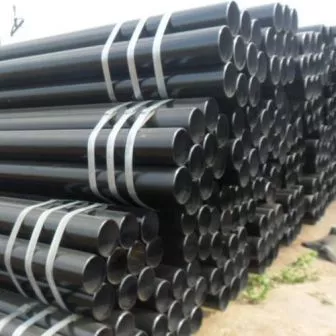In the manufacturing process of seamless steel pipes, the continuous pipe mill occupies a large share. There are many continuous pipe mills, including continuous mills with full floating mandrels, continuous mills with retained mandrels and continuous mills with semi-floating mandrels based on different operating modes of the mandrel.
Continuous mills with full floating mandrels were researched and developed by a company in Germany. The speed of continuous mills with full floating mandrels is not controlled, and the movement of the mandrel is complete driven by the friction of the milled piece, passing through the mill by relying on the friction of the steel pipe when they are working. In the continuous milling process, the speed of the mandrel will continue to change, which causes the wall thickness of the rolled workpiece to also change. After continuous milling, the mandrel moves with the milled piece to the runout table behind the mill, and the milled workpiece and the mandrel are horizontally moved to the stripping line. The mandrel will be removed from the milled workpiece by the stripping machine, and then it is cooled, lubricated and used again. Continuous mills with full floating mandrels have a fast milling speed, and they can manufacture 4 pipes. However, the accuracy of the wall thickness of the milled pipe is low and the production process is relatively long. The length of the mandrel is relatively long, which is close to that of the milled pipe. Continuous mills with full floating mandrels are only suitable for processing seamless steel pipes with small sizes.
The semi-floating mandrel continuous mill was developed by a French company. Its processes are as follows: the mandrel moves under the control of a certain speed, and it is released after the milling is complete; the milled pipe and mandrel are transported to the roller table of the mill, and then remove the mill; the mandrel is separated by the stripping machine; Using the technology of combining the ejector pin and mandrel into one, the milled pipe, ejector pin and mandrel are sent to the continuous mill, which greatly saves the auxiliary time between piercing and milling, reduces the time of removing the ejector rod from the milled pipe and then threading the mandrel and making the milling faster. The fastest milling can be 20 seconds for one.
The retained mandrel continuous mill was successfully researched and developed by an Italian company. The characteristic of retained mandrel continuous mill is that the mandrel moves at a uniform speed, because it is controlled by a gear rack when milling; the speed of the mandrel needs to be controlled, and it should be faster than the biting speed but slower than the throwing speed of the first rack. In the rolling process, the speed of the mandrel is controlled to be consistent, thereby reducing the impact of the mandrel's movement on the steel pipe and ensuring the accuracy of the wall thickness of the steel pipe. The operating speed of mandrel is different for the milling specifications of steel pipes. At the end of milling, the mandrel is stationary, and the milled pipe is removed from the mandrel by the pipe stripper; the mandrel is away from the mill and it is cooled and lubricated to be used again. In the continuous milling process, the retained mandrel continuous milling can increase the longitudinal flow of the steel pipe's metal and reduce the horizontal spread of the metal. The closed round hole selected increases the elongation of the first few racks, so the accuracy of the wall thickness of the steel pipe can be improved.
 The development of the foreign retained mandrel technology
The development of the foreign retained mandrel technologyThe retained mandrel is mainly adopted for the Accu-Roll mill. The Accu-Roll mill is also known as the retained mandrel Diescher mill. The concentricity and surface quality of the steel pipes manufactured by the Accu-Roll mill are good, but the production capacity is low and the produced steel pipes have smaller outer diameters. The production specifications are limited, so the Accu-Roll mill has not been widely used. Afterwards, three sets of retained mandrel Diescher mills with improvement were developed. After continuous research, development and experiments on retained mandrel Diescher mills, a brand new set of retained mandrel mill was designed, that is, the Accu-Roll mill, which was put into operation in 1988. It has an annual production capacity of 50,000 tons, and the outer diameter of the milled pipe is between 86 and 133 mm.
The development of retained mandrel in China
The retained mandrel mill was first introduced in China in the 20th century. Accu-Roll milling unit of Φ180 mm is set up in the original seamless steel pipe plant in Chengdu in 1992, and its products were used in military and industrial production. In the mid 1990s, China has successively built the retained mandrel Diescher mill production lines with Φ114 mm and Φ140 mm. In recent years, the restraint mandrel Diescher mill has made considerable progress, and the products are produced with more and more varieties and specifications. This unit has a wide range of product varieties and specifications, so it has become one of the main models for steel pipe manufacturers in China, which has promoted the development of seamless pipes in China.